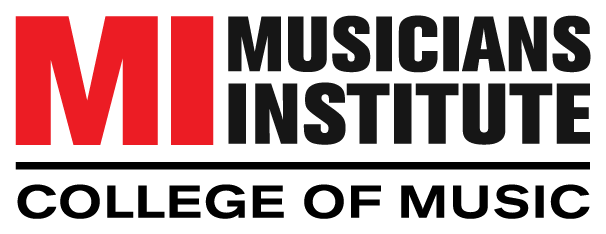Have you ever watched a great singer perform and wondered how they make it look so effortless? How they can hold a note forever, belt out a powerful chorus, or sing night after night without losing their voice. The secret is not just raw talent. It is built on a foundation of strong, healthy habits developed through dedicated practice.
Two of the most important tools for any singer are proper breathing exercises and a consistent warmup routine. Mastering these skills is like a builder learning to use a hammer and saw. They are the essential first steps to creating something amazing.
At Musicians Institute, we believe that understanding your instrument, your voice, is the first step to a successful career in music. Use this guide to understand the importance of breathing exercises and consistent warm-up routines.
Why Breathing Exercises Are Essential for Singers
Think about what happens when you sing. The sound is created when air from your lungs passes between your vocal cords, causing them to vibrate. Your voice is essentially a wind instrument. If you have ever tried to play a trumpet or a saxophone, you know you need a steady stream of air to make a good sound. The same is true for your voice.

Blog Post
"*" indicates required fields
By submitting this form, I authorize Musicians Institute (MI) to make or allow the placement of calls, emails, and texts to me at the phone number that I have provided, including through the use of automated technology, or a prerecorded or artificial voice. I understand that I am not required to provide my phone number as a condition of purchasing any property, goods, or services. I agree to the terms of MI’s Privacy Policy. MI will not sell or rent your information to third parties, and you may unsubscribe at any time.
The Importance of Breath Control for Vocalists
Breathing exercises for vocalists are not about taking a giant gulp of air right before you sing. They are about training your body to breathe in a way that supports your voice consistently and reliably. Performing a full setlist, especially one with demanding songs, requires serious vocal stamina. Breathing exercises are your daily training regimen for your voice. This foundational skill is what separates amateur singers from professionals
Expanding Lung Capacity for Singers
Many beautiful songs feature long, sweeping phrases that require a lot of air. Trying to sing these phrases with a small breath can feel like trying to fill a swimming pool with a garden hose. The goal of expanding your lung capacity is not to turn your lungs into giant balloons. Instead, it is about learning to use your lungs’ natural capacity more efficiently. Specific breathing exercises train your body to take in a fuller, deeper breath and then to release that air in a slow, controlled manner.
What is Diaphragmatic Breathing?
Many people breathe in a shallow way, using only the top part of their lungs. This type of breathing might be fine for everyday talking, but it is not enough for singing. Singing requires deep, controlled breath support that comes from your diaphragm, a large dome-shaped muscle located beneath your lungs. Breathing exercises teach you to engage this muscle and use your entire lung capacity, giving your voice the steady power it needs.
How Diaphragmatic Breathing Works
When you breathe diaphragmatically, your stomach should expand outward on the inhalation and gently draw inward on the exhalation. This controlled motion provides the stable airflow that is the bedrock of great singing technique.
Diaphragmatic Breathing Exercise for Breath Control
One effective exercise is to lie on your back with a light book on your stomach. Breathe in deeply through your nose, focusing on making the book rise. Then breathe out slowly through pursed lips, controlling the descent of the book for a count of five or ten seconds. Over time, this practice increases the flexibility and strength of your respiratory system.
Improving Vocal Stamina and Endurance
By practicing sustained breathing techniques, you are strengthening your diaphragm and your intercostal muscles, which are the muscles between your ribs that help control exhalation. The stronger these muscles become, the longer you can sing without feeling tired. This stamina allows professional singers to complete long tours and recording sessions with strong vocals from beginning to end.
The “Shhh” Breath (Breath Resistance) to Strengthen Muscles
This exercise uses a “shhh” sound (like telling someone to be quiet). The “shhh” creates more resistance than a vowel sound, which helps to strengthen the diaphragm and abdominal muscles. Inhale deeply, then exhale on a strong, steady “shhh” for as long as you can maintain consistency.
Protecting Your Vocal Cords from Damage
Your vocal cords are delicate muscles. Just like any other muscle, they can be strained or injured if they are misused. One of the most common causes of vocal strain is pushing or forcing the sound out without proper breath support. When you run out of air but try to finish a phrase anyway, you end up squeezing your throat muscles to get the sound out. This puts a lot of pressure on your vocal cords and can lead to swelling, hoarseness, and even long-term damage. Strong, consistent breath support acts as a protective cushion for your vocal cords. The air does the work, so your cords do not have to strain.
Straw Phonation Exercise for Breath Support
Place the end of a drinking straw in your mouth and hum or sing scales and simple songs through it. This technique creates back-pressure that helps the vocal cords vibrate more efficiently with less effort. It is an excellent exercise for warming up the voice while simultaneously focusing on steady breath support.

Advanced Breathing Techniques for Singers
Once you have mastered the basics of diaphragmatic breathing, you can begin to explore more advanced techniques that offer greater artistic control.
Building Breath Support for Dynamic Control
Messa di Voce is a common breathing technique to help vocalists manage subglottic pressure. During your vocal performance, subglottic pressure builds up beneath the vocal cords to manage volume and sustain. Practicing sustained notes while gradually increasing and decreasing volume is an excellent way to develop this fine control.
Messa di Voce (The “Message of the Voice”) for Regulating Subglottic Pressure
Choose a comfortable, sustained pitch in the middle of your range. Start the note very softly (pianissimo). Gradually and smoothly swell the volume to its loudest (fortissimo), and then, just as smoothly, diminish it back to the softest volume. The entire process should be seamless, with no wavering in pitch. This teaches you to finely increase and decrease subglottic pressure while maintaining cord closure.
Developing Agility and Speed for Breath Control
Vocal agility is the ability to move quickly and accurately between notes. This skill is also built on a foundation of great breath control. Fast runs and riffs require tiny, precise bursts of air. Without controlled breath support, these passages can sound sloppy and out of tune.
Staccato Exercise to Improve Appogio
Practice short, staccato exercises on a vowel sound like “ee,” using a quick, controlled burst of air for each note. This trains your breath to respond with precision to the demands of the music, giving you the ability to execute complex melodic patterns with ease and confidence.
Daily Vocal Warm-Up Exercises for Singers: Preparing for Performance
After you have focused on your breathing, the next step is to warm up your voice itself. Just as an athlete stretches their muscles before a game, a vocalist must gently awaken the vocal cords before singing. A good warm-up prepares your voice for the work ahead, improves your tone, and helps prevent injury. It should start gently and gradually increase in intensity.
A proper vocal warm-up should take at least ten to fifteen minutes. Rushing this process is one of the biggest mistakes a singer can make. The goal is to gradually increase blood flow to the vocal cords and surrounding muscles, making them more pliable and responsive.
The Lip Trill Vocal Exercise for Breath Support
The lip trill, sometimes called a lip bubble, is one of the best all-around vocal warm-ups. This warm-up is excellent because it helps coordinate your breath and your voice while keeping the vocal cords lightly connected. Here’s how to do a lip trill:
- Relax your lips and blow air through them so they vibrate against each other, creating a brrrrr sound, like a motorboat.
- Add your voice to this sensation, sliding up and down your range.
- If you have trouble getting your lips to trill, try placing two fingers gently on your cheeks and pushing them slightly towards your mouth.
Benefits of the Lip Trill for Vocalists
The vibration also helps relax the lips and face, reducing tension which can negatively impact your sound. Start in a comfortable part of your range and slide up and down slowly. The goal is to keep the trill steady and even, which requires a consistent flow of air from your diaphragm. This exercise is a fantastic check-in for your breath support before you even start singing notes.
The Slide Technique for Vocal Range
The slide, or siren, is a simple but powerful exercise for connecting the different parts of your vocal range. It helps smooth out the transitions between your chest voice and your head voice, making your entire range feel more unified and even. Here’s how to perform a slide:
Start on a comfortable note and smoothly glide your voice up to a higher note, and then back down, like the sound of a siren. You can do this on a vowel sound like “oo” or “ee.” The key is to make the slide as smooth as possible, with no breaks or sudden jumps in the sound.
Benefits of the Slide in Warm-Ups
The slide encourages flexibility in the vocal cords. Start with small slides within a comfortable interval, like a fifth, and gradually make them larger as your voice becomes more warmed up. Focus on maintaining a consistent tone and air pressure throughout the entire slide. Always avoid any pushing or straining as you approach the top of the slide, since this can cause damage.
The Mmm-Ah Exercise for Resonance
This exercise is fantastic for bridging the gap between a hum and an open vowel sound, which helps with resonance and tone placement. Here’s how to correctly use Mmm-Ah exercises:
- Begin by humming a comfortable note on the Mmm sound. Feel the vibration in your lips and the front of your face. This is called forward placement, and it helps create a bright, clear tone that carries well.
- After holding the hum for a moment, smoothly open your mouth into an Ah vowel, as in the word father. Try to keep the same resonant feeling in the front of your face when you switch to the Ah.
Goals of Using Mmm-Ah Exercises
The goal is to have a consistent, beautiful tone from the hum to the open vowel. This teaches your voice to maintain good resonance even when the shape of your mouth changes. Consistent resonance is essential for singing different vowels and lyrics clearly. If you’re new to this technique, start by practicing with just one note. As you become more comfortable, you can challenge yourself by sliding from a low note to a high note on the Mmm-Ah pattern.

Expand Your Vocal Range Safely with Daily Practice
One of the most exciting goals for any singer is to expand their vocal range. Using these exercises and techniques in your daily practice will help, but it can take weeks or months to build the necessary strength. It’s important to always use proper technique and avoid pushing your voice to extremes. Singing extreme notes incorrectly can cause vocal nodes or other severe injuries.
Gentle, Consistent Practice is Key
The true way to safely expand your range is through consistent, gentle breathing exercises and warmups. The highest and lowest notes in your range are often the most fragile, and they require excellent breath control to access without strain. A strong diaphragm provides the necessary support to gently explore these outer limits.
Vocal Techniques for Range Expansion
Exercises like the lip trill and the slide gently encourage your vocal cords to stretch and become more flexible. When you practice these exercises daily, you are not straining. You are slowly and safely exploring the edges of your range with the support of your breath. Over time, notes that once felt difficult or out of reach will become more accessible.
Importance of Proper Technique in Warm-Ups
The strength and control you build in the middle of your range provide a solid foundation for carefully venturing higher and lower. Patience is key. Expanding your range is a gradual process that can take months, but with dedication, you will be amazed at what your voice can achieve. Always listen to your body. If you feel any pain or discomfort, stop immediately. A slight feeling of stretch is normal, but pain is a warning sign.
Refine Your Vocal Techniques
Your journey as a vocalist begins with consistent practice and the right technique. Singing is about discovering the power and beauty of your own unique instrument. By making breathing exercises and a proper warmup part of your daily routine, you invest in your long-term health and success. These habits form the foundation of strong singing, giving you stamina, control, and protection so you can shine on any stage.
Start Your Vocal Journey at Musicians Institute
At Musicians Institute, we help you build strong skills in a friendly and inspiring setting. Our vocal program in Los Angeles teaches the same methods that professional singers use every day. Our central location is ideal for aspiring musicians and producers. Students have access to live venues, premier internships, and a vibrant community of musicians who share their passion.
Our world-class instructors and state-of-the-art facility provide an ideal learning environment. Our curriculum covers everything from vocal health and technique to performance and artistry. Your voice holds potential, and we are here to help you unlock it.

